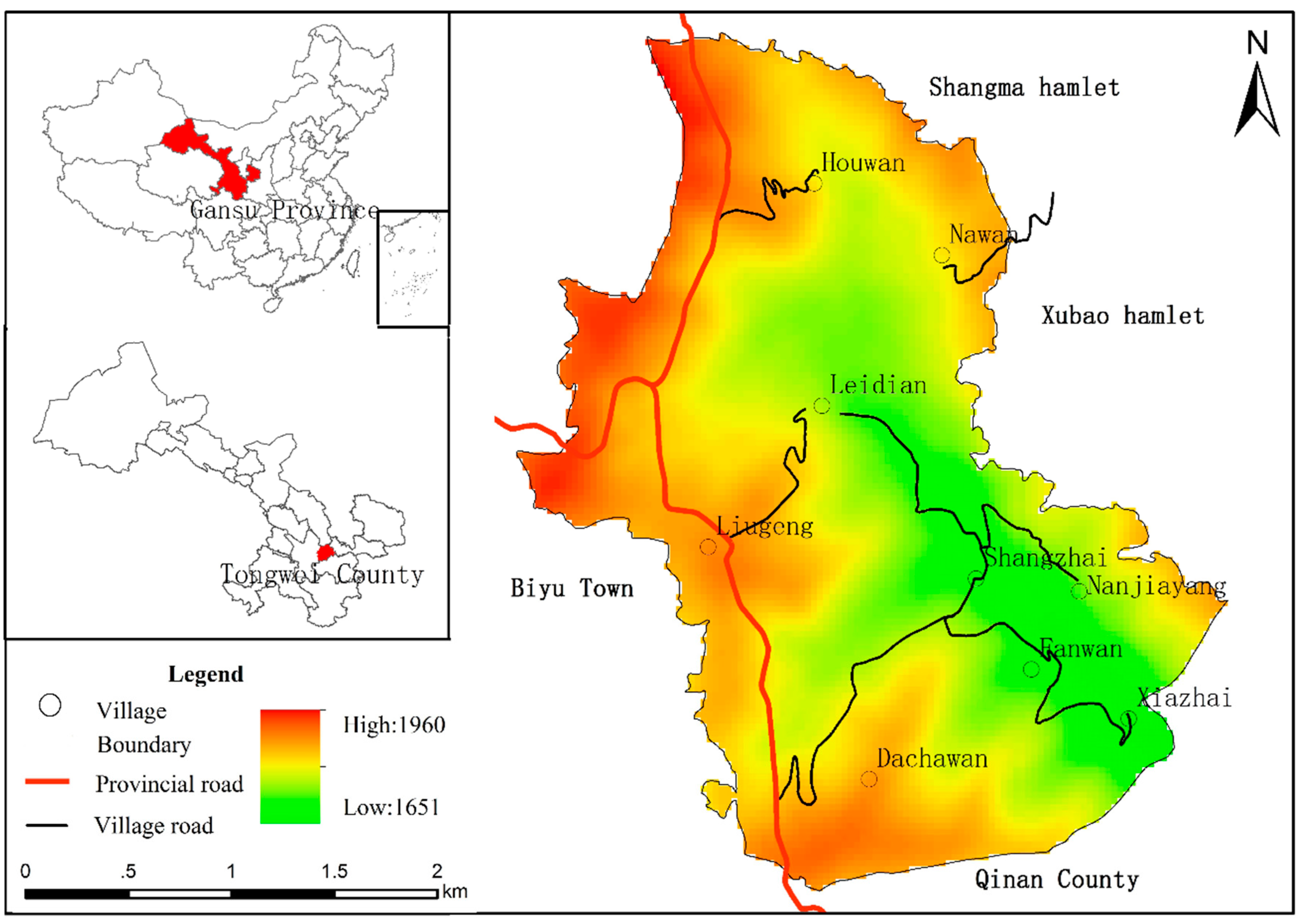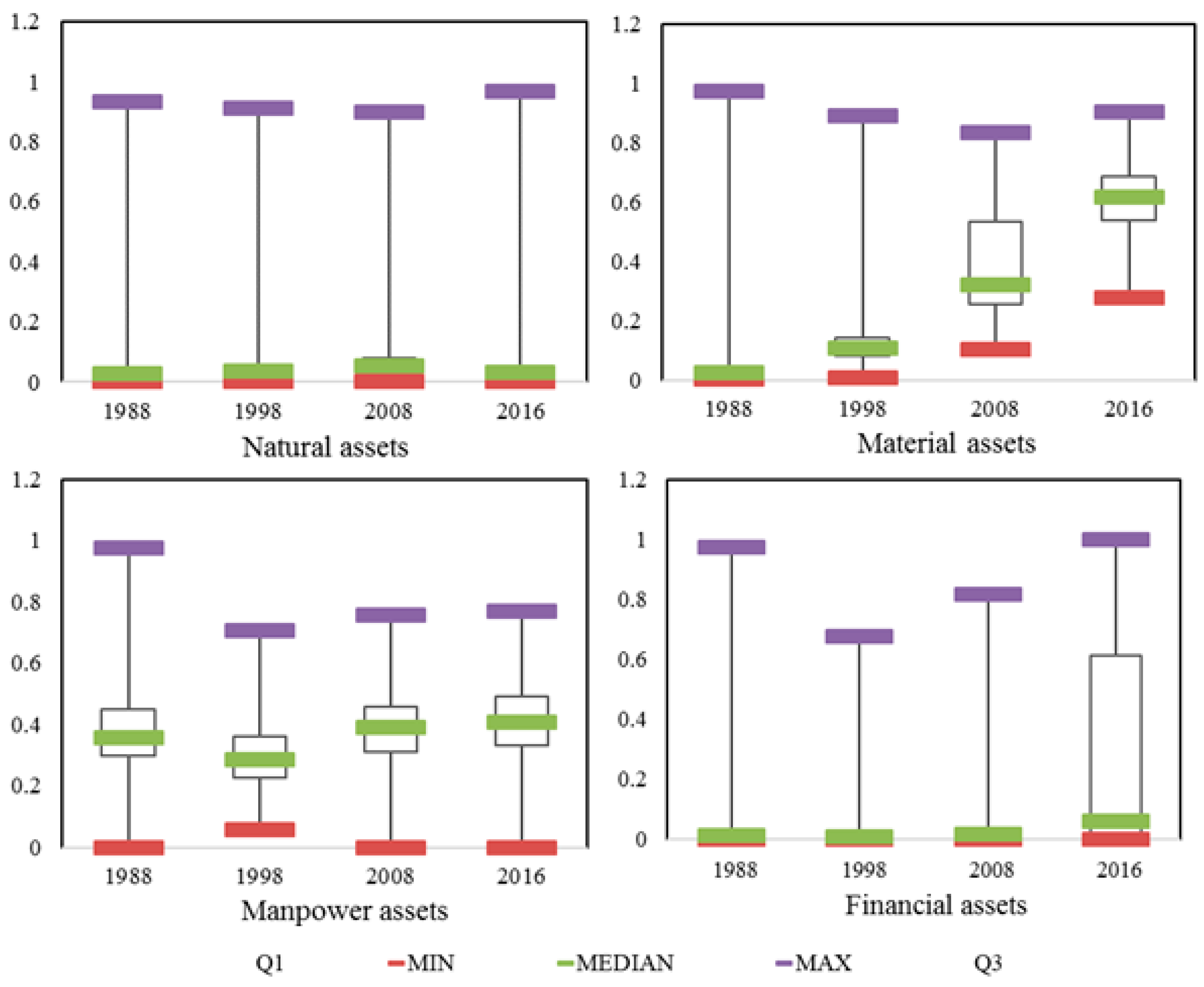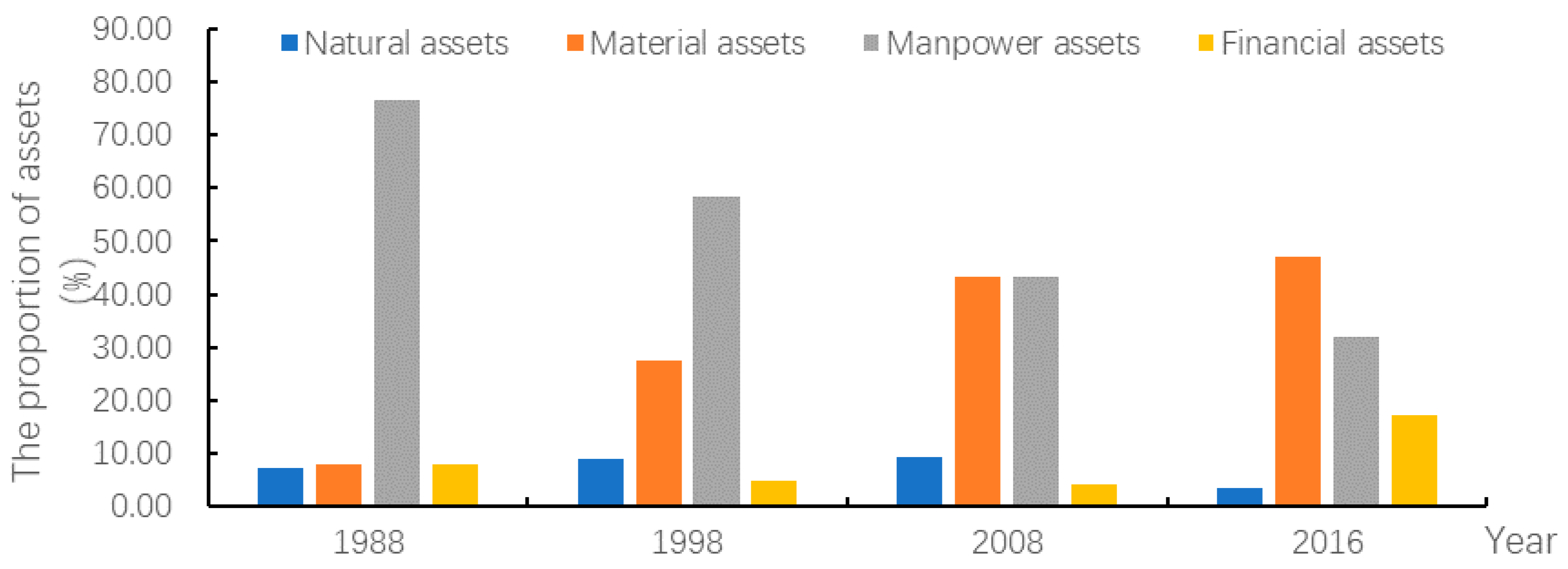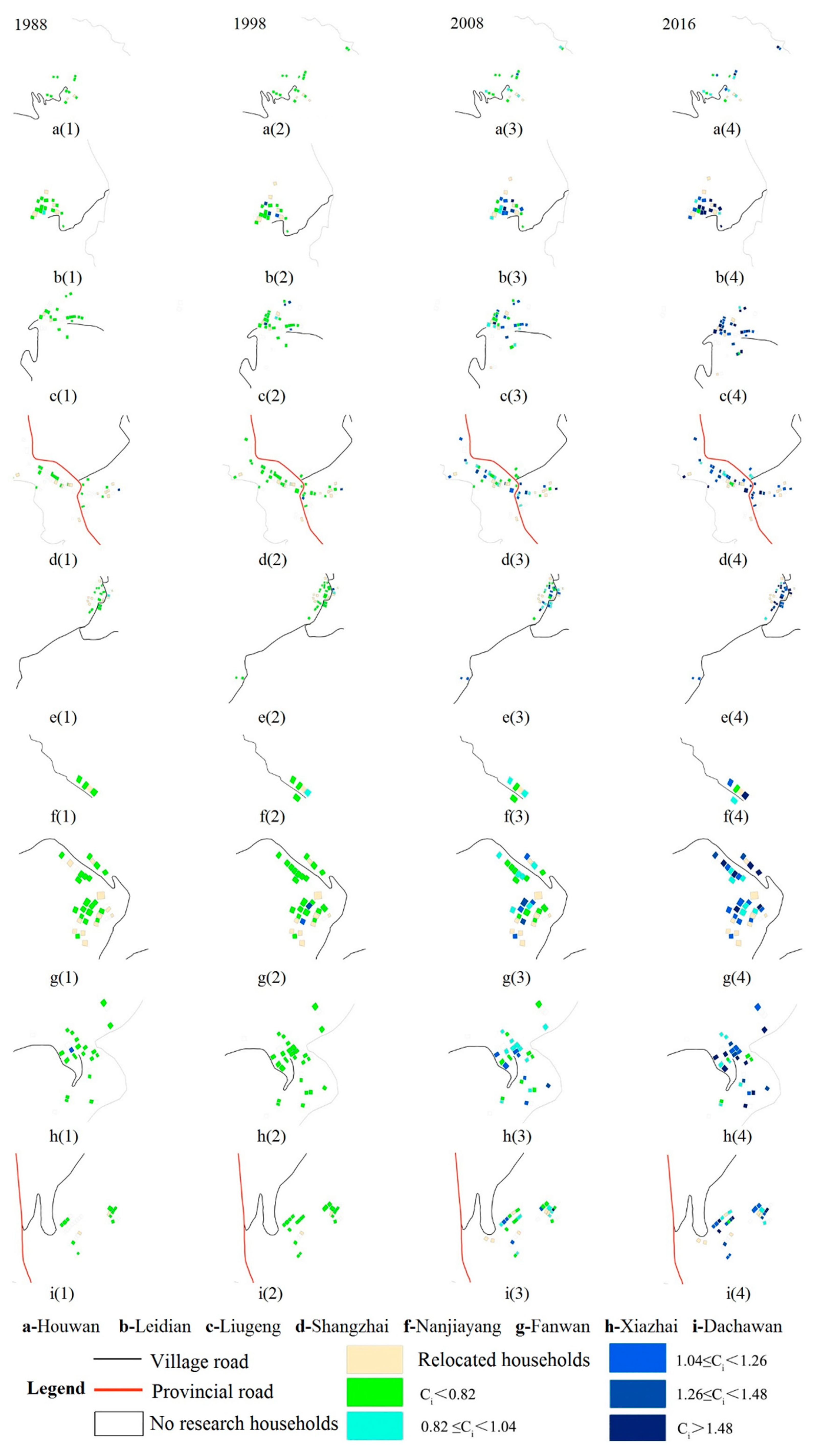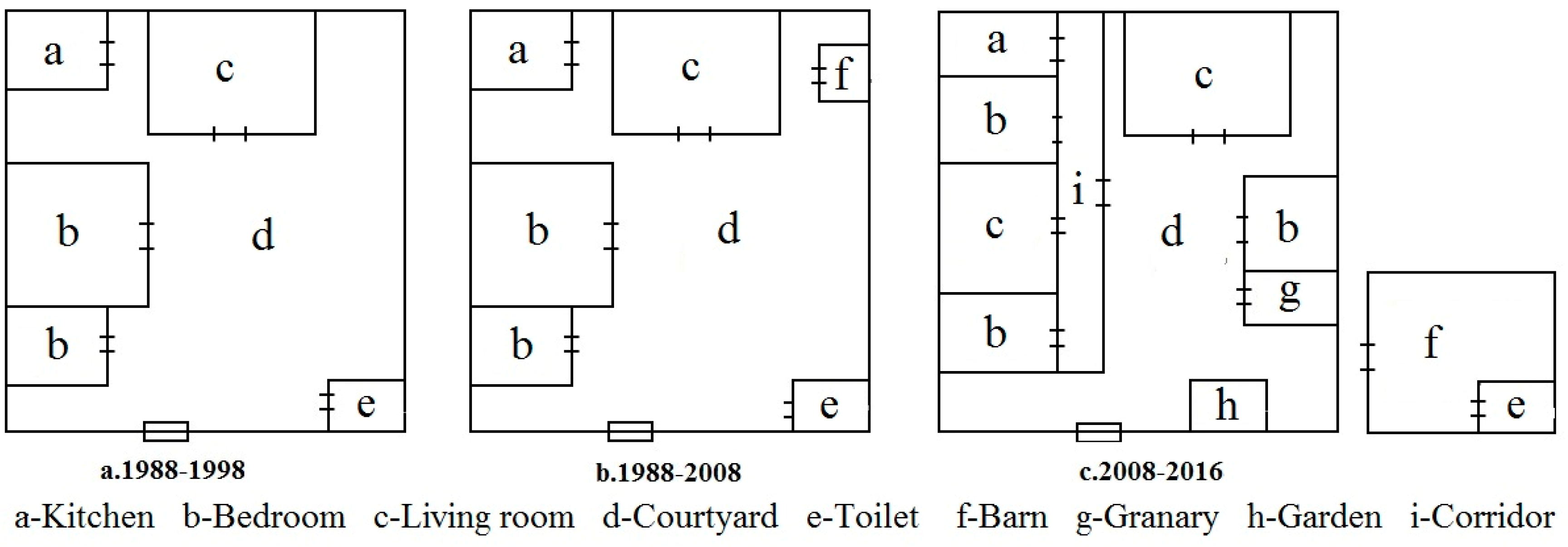1. Introduction
The steady progression of new industrialization, healthy urbanization, and agricultural industrialization speeds up the differentiation of rural households in China. Accurately identifying the characteristics and trend of household differentiation in this background can provide a basis for identifying the livelihood challenges that rural households face in the future and effectively solving the three rural issues, which has received extensive attention [
1,
2,
3]. Since the reform and opening-up policy was implemented, China has sequentially formulated and released 20 No.1 documents addressing the “three rural (agriculture, rural areas and farmers)” issues. The five No.1 documents released in 1982–1986 mainly focus on rural reform and agricultural development, including the household contract responsibility system and agriculture serving as the basis of national economy, increasing rural investment, and other rural reform policies. These have effectively promoted the reform of the circulation system of agricultural products and agricultural industrialization. However, the progress of rural reform was still relatively slow, and the income gap between urban and rural areas was widened. The 14 No.1 documents released in 2004–2017 emphasize the extreme importance of the three rural issues in the socialist modernization of China. The formulated policies include the promotion of farmers’ income, the new socialist countryside, the agricultural modernization, the integration of urban and rural development, the supply-side structural reform of agriculture, and many other policies which can benefit the development of agriculture and farmers. These polices have solved many problems in rural development, promoted the construction of new socialist countryside and narrowed the gap between urban and rural areas. The No.1 document released in 2018 proposed to implement the strategy of rural revitalization. It also put forward specific goals for speeding up agricultural modernization and taking a characteristic Chinese road to revitalizing socialist villages. These are the necessary requirements for achieving the common prosperity of all people in China. The above-mentioned No.1 documents reflect the different focus of three rural issues at different stages of development of China. These policies also have great influence on rural livelihoods [
4,
5,
6]. A secure livelihood is the main goal of human activities. By production and consumption activities, humans exert influences on land. Livelihood is thus the major driving force of evolution of human-land systems. Rural households are the basic units and micro business entities for the economic and social development in rural areas. Their livelihoods include the abilities and assets required for survival and development, production activities, and rights to obtain all of these. Since the reform and opening-up policy was implemented, rural households, under the influence of industrialization and urbanization, have had more livelihood choices, which leads to continuous livelihood change [
7,
8]. This further affects land use process, ecological environment evolution, natural resource management, ecological compensation, and livelihood resource allocation [
9,
10,
11]. Livelihood assets, livelihood strategies, and livelihood outcomes are at the core of rural household livelihoods. Rural households utilize obtainable livelihood assets, select proper livelihood strategies and obtain livelihood outcomes. The amount of livelihood assets that rural households have determines their consumption-type investment and further affects the construction of rural settlements. Livelihood assets, as the basis of livelihood structure, determine the selection of livelihood strategies, thus accurately quantifying the livelihood assets of rural households can help identify the trend of their development [
12,
13,
14,
15].
Rural settlement is not only a place where farmers live, but also an important production space. It is a “complex” with multiple functions closely related to rural household livelihoods [
16,
17,
18]. The formation and development of rural settlements is not only a result of households’ diverse selection of livelihoods but also a result of the process where households influence the pattern, form, and structure of rural settlements. Finally, rural settlement land use experiences significant changes and settlements are even re-constructed [
19,
20]. The form and function of rural houses change greatly with time and livelihoods. At the same time, due to the changes in the spatial pattern and form of rural settlement, farmers also need to change their livelihoods in order to adapt to the new spatial pattern of rural settlement [
21,
22,
23]. For a long time, researchers, restricted by their own disciplines, have either studied household livelihood strategies, quantification of livelihood assets, and livelihood changes from the perspective of regional economics and sustainable development [
24], or studied spatial evolution of rural settlements from the perspective of settlement geography [
25]. All of them have just studied single problems from single perspectives. There is little research combining both perspectives, which is not conducive to revealing the internal mechanism of rural settlement evolution from multidimensional scale. In fact, the evolution of rural settlements is not only related to natural and social economic factors, but also closely related to the change of farmers’ livelihoods [
26]. The spatial-temporal variation of livelihoods leads to difference in rural settlement land use. Current research has mostly focused on the former while ignoring the latter. In addition, most of the research mainly concentrates on county or a larger scale [
27], but neglects the most basic unit of rural settlements, i.e., village. Therefore, the research results cannot well guide the village-scale construction.
Rural settlement actually consists of rural households and rural households are the main subjects of economic activities in rural areas. Because of the difference in family economic income and the change of consumption concept, the cognition, demand, and decision making towards residential improvement vary from household to household. The rural residential land use change in the new period is no longer the pure expansion and merging of areas, but reconstruction and integration at the village scale under the influence of farmers’ production and living behavior. This can comprehensively reflect the development of village, agriculture and rural households. In this paper, Sihe village (Jichuan Town, Tongwei County, mid-Gansu loess hilly region, China) was taken as an example. Based on the participatory rural assessment method (PRA), household survey was conducted to analyze the allocation of household assets and livelihood diversification since 1988. We also explored the influence of farmers’ livelihood change on rural settlement land use. The biggest difference between our paper and previous studies lies in that: We analyzed the temporal changes of farmer’s livelihoods and rural settlement land use, constructed a matrix showing the farmers’ livelihood strategy change, explored the process and the key period of livelihood change, and revealed the relationship and response mechanism between livelihood change and rural settlement land use change. The results might provide theoretical reference for the selection of new village location, reconstruction of rural settlements, and creation of livable rural environment.
2. Overview of Study Region
Sihe village is located in mid-Gansu loess hilly region, in the western part of Jichuan Town (Tongwei County, Gansu Province, China). It has a total area of 7.71 km
2, 15 km distant from town area and 25 km distant from county seat. Sihe village is adjacent to Shangma village and Xubao village (Tongwei County) in the northeast, and Wangfu Town (Qinan County) in the southwest. It is located between 105°25′52.97″ E, 35°8′10.21″ N. The elevation of most regions in Sihe village ranges from 1600 to 2000 m, with an average elevation of 1763 m. Sihe village has a warm, moist climate, with enough solar radiation, average annual rainfall of 450 mm, and frost-free period of 150 days [
28] (
Figure 1).
Sihe village has jurisdiction over nine communities, including Dachawan, Shangzhai, Leidian, Napowan, Houwan, Nanjiayang, Xiazhai, Fanwan, and Liugeng. Among them, liugeng is located on the top of mountain, Shangzhai and Xiazhai are located in valley bottoms, and the remaining communities are distributed on mountain slopes. In 2017, there were a total of 327 households in Sihe village. The total population was 1233, among which 700 were labor force participants. The per capita net income was 3000 Yuan. The total cultivation area was 452.13 hm
2, with per capita cultivation area of 0.31 hm
2 [
29].
There are three reasons why Sihe villages was selected for investigation: (1) It is a typical poor village. Tongwei County is a poor county of China, and Sihe village is a poor village in Tongwei County. In Sihe village, the scale and mechanization of agricultural land management are relatively low. In addition, the residence is less limited by the farming radius, but it is greatly influenced by the production and lifestyle of farmers; (2) The development context for Sihe village is complete and clear. The development of this villages is closely related to national policies. Since the reform and opening up in 1978, it has been in a relatively stable state of development, with a complete social transformation process; (3) Household livelihoods and evolution patterns of Sihe village are typical and representative. The production and lifestyle of farmers as well as the scale, structure, and morphology of rural settlement land use in Sihe village are universal in mid-Gansu loess hilly region, thus the study of the Sihe village can provide theoretical reference for the construction of other rural settlements.
5. Discussion
With the progression of industrialization and urbanization, the works and working locations of farmers have changed significantly. The production activities of rural households in China gradually change from agricultural–non-agricultural production to non-agricultural production and in-situ non-agricultural production. When households engage in the former, they “leave the land but not the village” in certain season when non-agricultural production occurs. When households engage in the latter, however, they “leave the land and the village”. In rural areas of China, farmers’ ways of production, lifestyles, and ways of communication become more “social” [
36]. Rural settlements are places where villagers live and engage in production activities. The scale, structure, and morphology of rural settlement land use gradually change as livelihoods change and social economy develops [
37].
5.1. Comparison of Livelihood Assets Evaluation Models
Many frameworks have been proposed for livelihood analysis, such as the analytical framework developed by the Department for International Development (DFID), the United Nations Development Programmed (UNDP), and Care International (CARE) [
15,
38]. However, the most widely used framework is the analytical framework developed by DFID, that is, the SL framework [
38]. This framework provides the main idea for the study of farmers’ livelihoods here, and it is helpful to clarify the intricate relationship among many factors affecting farmers’ livelihoods. It considers farmers as subjects that make a living in a specific vulnerable background. In this context, livelihood assets are the key and core of the whole livelihood analysis framework. The nature and structure of livelihood assets determine the livelihood strategies adopted by the farmers, and different livelihood strategies will lead to different livelihood outcomes. Meanwhile, the livelihood outcomes have counterproductive effects on livelihood assets, which in turn determine the nature and structure of livelihood assets [
30].
The framework developed by DFID provides a good way of livelihood analysis. It provides guidance for the study of livelihoods and poverty and identification of the core factors that affect livelihoods as well as the links and interactions among all factors [
19]. On this basis, targeted measures can be designed. The framework can be applied to different scales, such as countries, regions, small basins, villages, families, and individuals, and it is conducive to improving our understanding of the livelihoods of people, especially poverty-stricken or marginalized groups [
39].
5.2. Household Livelihood Change Promoted by the Development of Social Economy
The structure and spatial distribution of livelihood assets determine the resource advantage and spatial possibility of household livelihood development [
40]. The differentiation of rural households is mainly restricted by the development of local social economy and other external factors. Changes of rural household livelihoods will lead to changes of farmers’ land use concepts and behaviors, and further influence land use and economic development at village scale or even a larger scale [
41]. For Sihe village, 2008 was a key year of livelihood change. The livelihood asset structure, livelihood diversity index, and livelihood strategy changed oppositely before and after 2008. In general, livelihood change in Sihe village was driven by two aspects: (1) changes of farmers’ ideas under the development of local social economy and other external environmental factors (2) the implementation of national and local rural development policies. When different policies were implemented, rural areas developed towards different directions and farmers had different ways of production and lifestyles, which directly affected their livelihoods.
Since the reform and opening-up policy were implemented in 1978, the reform of household contract responsibility system has proposed, the central No.1 document on the theme of “three rural” which has been released from 1982 to 1986 for five consecutive years, has promoted the rapid growth of agriculture for more than 10 years, greatly supported the development of China’s economy, promoted farmers’ enthusiasm in agricultural production. With increase in agricultural inputs such as pesticides, fertilizer, and other production factors, land productivity has been significantly improved. At the same time, with the progression of industrialization, rural households begin to seek non-agricultural livelihoods. With the improvement of farmers’ material living standards, agricultural livelihoods are unable to satisfy their various consumption needs. Driven by both higher income and more benefits, some farmers start to seek new livelihoods, so the livelihood diversity and livelihood assets are gradually increased. In the mid and late 1980s, the focus of national reform shifted from rural areas to cities, opening up the new era of China’s urban economy development and having a huge impact on the countryside. From 1988 to 1998, increase in households’ livelihood assets was due to improved livelihood diversity and more to increased manpower assets. In this period, both the number and education level of labor force participants were increased. This suggested the importance of population size and quality in this period. In the late 1990s, the impact of urbanization and industrialization on agriculture was aggravated, farmers’ enthusiasm for grain was greatly frustrated, the increase of farmers’ income was slowing down, and the income gap between urban and rural residents continued to expand. In the six years from 1997 to 2003, the income ratio of urban and rural residents increased from 2.47 to 3.23. Therefore, the state has made great efforts to adjust the strategy of urban and rural development and the policy of guidance. After 18 years, the theme of Document No.1 of the Central Committee, which began in 2004, returned to the three rural areas again, and thus has been continued to the present. Under the influence of various national policies and socialist market economy, agricultural production has been gradually mechanized and there has been surplus labor force in rural areas of China, farmers’ concepts about living and production change continuously. As farmers’ response to industrialization and urbanization become stronger, some of them give up raising livestock and poultry and transfer to non-agricultural sectors. Meanwhile, with increase in income, farmers have higher requirements for production and living conditions. Part of their income is spent on home improvement, purchasing of electrical appliances and production tools, etc. Therefore, farmers’ material assets have increased and basically remained stable after 2008.
5.3. Rural Settlement Land Use Change Driven by Household Livelihood Change
Rural settlement is a place where farmers live and engage in production activities. With changes in livelihoods, the scale, structure, and morphology of rural settlement land use have also changed [
25]. Under the comprehensive influences of internal and external factors, farmers change the size, structure, and morphology of their houses to adapt to their livelihood changes [
42]. These changes can lead to changes of rural houses’ functions and eventually lead to changes in rural settlement land use [
43]. From 1988 to 1998, farmers mainly relied on agricultural livelihoods. In order to adapt to their livelihood needs, farmers planted vegetables and raised livestock/poultry in their yards and places around their residence. By engaging in various agricultural production activities, farmers tried to maximize their income. As a result, there was continuous expansion of rural settlement areas and the land use efficiency was relatively low. In addition, under the influence of family concepts and living habits, some families with a large size were gradually divided into families with a smaller size. Therefore, new houses needed to be built and the number of rural settlements increased. After 2000, with changes in agricultural production activities, the size and internal structure of farmers’ houses also changed greatly. The yard was paved with concrete or other materials so that food could be sun dried on its hardened surface. Barns in yards were changed to storage rooms to store food and agricultural machinery. Temporary barns were built outside the yard. When the prices of livestock products were high, farmers might raise livestock in their barns. Such temporary barns can be demolished whenever necessary and then the land can then be used for other purposes. In this period, although the homestead area decreased, the area of land used for production activities did not decrease.
The morphology of rural houses also changes with changes in livelihoods. Improved livelihood diversity and non-agricultural livelihoods result in good livelihood outcomes, thus farmers have higher ability to invest in house construction [
44]. In villages close to urban areas, non-agricultural economy is developed. Since only a limited area of land for non-agricultural uses is allocated to farmers, they build new space in their yards or around their homes for non-agricultural production. Therefore, their homes are not only places where they live, but also places where production activities occur. However, if farmers find a job in nearby towns or cities, non-agricultural production activities will not occur in their homes, which will then become places in which they live. As can be seen, the morphology of houses is changed by farmers so that the functions of the houses can adapt to the changes in livelihoods.
During field investigation, we found that the size, structure, and morphology of farmers’ houses are not simply determined by their livelihoods, but also affected by geographical environment, cultural customs, national policies, etc. [
45]. However, farmers can actively change the structure and morphology of their houses to adapt to the changes in livelihood needs and thus change the functions of their houses. This is an important perspective from which we can study rural household livelihood changes and their influence on the morphology and functions of rural houses. It is also a perspective from which we can study changes in rural settlement land use and provide guidance for rural construction.
5.4. Household Livelihoods and Reconstruction of Rural Settlements
Zhang thought that the rapid urbanization in China has led to great changes in economic space, social space, and settlement space in rural areas, and rural reconstruction in China should focus on the reconstruction of rural space system [
46]. Mid-Gansu loess hilly region is characterized by fragile ecological environment, shortage of land for cultivation, and low land use efficiency. Livelihood changes promote changes in rural settlement land use, and phenomena such as rapid random expansion of residential areas, rural hollowing, and idle houses occur, which greatly limit the sustainable development of rural settlements [
47]. Rural houses, as the places where farmers live and engage in production activities, are closely related to the actual livelihood needs of farmers. Changes in farmers’ livelihoods can promote changes in the morphology and functions of rural houses and further lead to changes in rural settlement land use, which has become an important reference for new rural construction [
6]. Therefore, in the background of farmer differentiation and livelihood change, the structures and morphology of rural houses should be adjusted according to the livelihood characteristics and needs of farmers and finally the goal of rural settlement adjustment can be achieved. This is also the area that we will further investigate in depth.
Based on the relationship between rural livelihood change and land use change, the way and pattern of rural reconstruction should be explored and institutional innovation should be promoted to support rural reconstruction, which is a typical example of combination of rural reconstruction theory and practice [
48]. With livelihood changes, farmers’ lifestyles and ways of production also change, which further promote changes in rural society and living space. Rural revitalization has become one of the major driving forces of rural settlement reconstruction. In mid-Gansu loess hilly region, rural settlement reconstruction should be based on farmers’ livelihood assets and needs of livelihood change. It should not only satisfy the living needs of farmers but also consider the overall living condition in the village. In addition, rural settlement reconstruction should consider both housing construction in the past and farmers’ residence willingness and preferences in the future [
15]. By rural settlement reconstruction based on household livelihoods and national policies, phenomena such as rural hollowing can be greatly reduced and residential land use efficiency can be improved.
